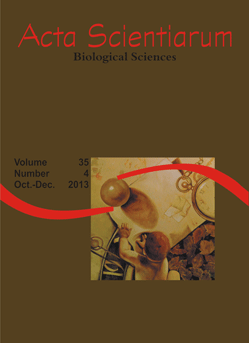<b>Structure of planktonic ciliates community (Protist, Ciliophora) from an urban lake of southern Brazil</b> - doi: 10.4025/actascibiolsci.v35i4.18579
Abstract
This study examined temporal and spatial (vertical) variations of composition, richness and abundance of the planktonic ciliates community in an urban and eutrophic lake, as well as identified the limnological factors involved in determining the patterns observed. To this end, samples of ciliates and measures of limnological variables were taken at different depths and hydrological periods. 35 ciliate species were identified, among which 14 species occurred in all periods and strata, being Prostomatida the most specious, followed by Gymnostomatida, Oligotrichida, Peritrichida, and Scuticociliatida. The patterns found for composition, abundance and species richness evidenced a vertical and temporal variation of these attributes. However, in general the composition and species richness have varied more along the vertical gradient than between periods, whereas for the abundance, only temporal differences could be detected. Results observed herein indicated that benthic species seem to be mainly influenced by the amount of organic matter, phosphorus and ammonia, while planktonic ones, abundant at the surface, were mainly associated with higher dissolved oxygen concentrations. In this way, seasonal and vertical variations of limnological characteristics were decisive for the patterns of occurrence and abundance of ciliate species.
Downloads
DECLARATION OF ORIGINALITY AND COPYRIGHTS
I Declare that current article is original and has not been submitted for publication, in part or in whole, to any other national or international journal.
The copyrights belong exclusively to the authors. Published content is licensed under Creative Commons Attribution 4.0 (CC BY 4.0) guidelines, which allows sharing (copy and distribution of the material in any medium or format) and adaptation (remix, transform, and build upon the material) for any purpose, even commercially, under the terms of attribution.
Read this link for further information on how to use CC BY 4.0 properly.












1.png)




3.png)













